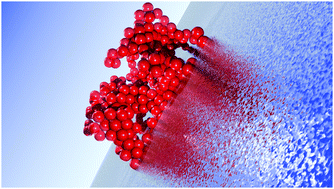Structural fingerprints of yielding mechanisms in attractive colloidal gels†
Abstract
Core-Modified Dissipative Particle Dynamics (CM-DPD) with a modified depletion potential and full hydrodynamics description is used to study non-equilibrium properties of colloidal gels with short range attraction potentials at an intermediate volume fraction (ϕ = 0.2) under start-up shear deformation. Full structural and rheological analysis using the stress fabric tensor complemented by bond number and bond distribution evolution under flow reveals that similarly to dilute colloidal gels, flow-induced anisotropy and strain-induced stretching of bonds are present during the first yielding transition. Unlike in low volume fraction depletion gels however, a small fraction of bond dissociation is required to facilitate bond rotation at intermediate volume fractions. The strain at which structural stretching and anisotropy in bond distribution emerge coincides with the first maximum in the shear stress (first yielding transition). At higher strains, depending on flow strength, a second peak in stress signal appears which is attributed to the compaction and melting of clusters. In this work, for the first time we provide evidence that multibody hydrodynamic interactions are essential to predict the correct dynamics of depletion gels under flow, namely two-step yielding process.


 Please wait while we load your content...
Please wait while we load your content...